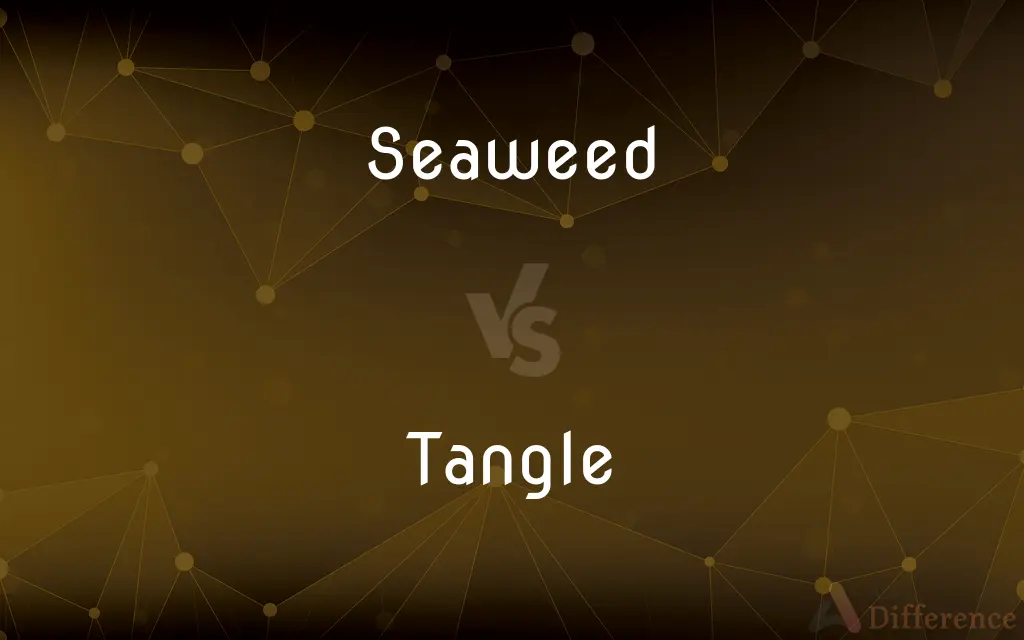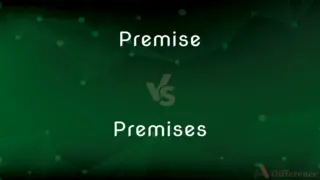Seaweed vs. Tangle — What's the Difference?
By Fiza Rafique & Urooj Arif — Updated on April 1, 2024
Seaweed refers to diverse marine algae species, beneficial in cuisine and industry, while tangle denotes a specific kelp species, known for its long, entangled fronds in cold seas.

Difference Between Seaweed and Tangle
Table of Contents
ADVERTISEMENT
Key Differences
Seaweed encompasses a broad range of marine plants and algae, thriving in various marine environments, from intertidal zones to deep waters. These organisms play crucial ecological roles, serving as food, shelter, and oxygen producers for marine life. Tangle, or Laminaria digitata, is a specific type of large, brown seaweed (kelp) found in the subtidal zones of cold seas, recognized by its long, leathery fronds that often form dense underwater forests.
Nutritionally, seaweed is celebrated for its rich content of vitamins, minerals, and fiber, varying widely among species. It's a staple in many Asian cuisines, known for its umami flavor. Tangle, as a form of kelp, is particularly noted for its high iodine content, making it a valuable dietary supplement, especially for thyroid health. It's also used in traditional dishes in regions like Scotland and Ireland.
In ecological terms, seaweed species, including kelp forests where tangle is found, act as vital components of marine ecosystems. They provide habitat and nursery grounds for various marine species and help in carbon sequestration. Tangle's dense fronds offer protection and food to a diverse array of marine life, contributing significantly to the biodiversity of its habitat.
Commercially, seaweed is used in a wide array of products, from food additives to cosmetics and fertilizers. Its versatility stems from its varied species and properties. Tangle, specifically, has applications in the food industry as a source of alginate, a thickening and stabilizing agent, and is researched for its potential in biofuel production due to its rapid growth rate.
The cultivation practices for seaweed range from open-ocean farms to controlled aquaculture systems, adapting to the specific requirements of different species. Tangle cultivation, though less common than some other seaweeds, involves methods tailored to its growth habits and environmental needs, often focusing on sustainable harvesting from wild stocks.
ADVERTISEMENT
Comparison Chart
Definition
Diverse marine algae species, including plants and kelp.
A specific species of kelp with long, entangled fronds.
Nutritional Value
Rich in vitamins, minerals, and fiber, varies by species.
High in iodine, beneficial for thyroid health.
Ecological Role
Crucial for marine ecosystems, offering habitat and oxygen.
Forms dense underwater forests, supporting marine biodiversity.
Commercial Use
Wide array, including food, cosmetics, and fertilizers.
Used for alginate production and studied for biofuel potential.
Cultivation
Varies widely among species, from aquaculture to open-ocean farms.
Tailored to its specific growth habits and environmental needs.
Compare with Definitions
Seaweed
Utilized in numerous industries for its unique properties.
Seaweed extracts are common in skincare products.
Tangle
Focus on sustainable practices in wild stock harvesting.
Tangle harvesting regulations ensure ecosystem health.
Seaweed
Plays a vital role in marine biodiversity and carbon sequestration.
Seaweed forests are home to diverse marine life.
Tangle
Its dense fronds offer habitat and food for marine species.
Tangle forests support a variety of fish and invertebrates.
Seaweed
Includes various species, from microalgae to large kelp.
Nori and kelp are popular types of seaweed.
Tangle
Known for its long, leathery fronds that form dense forests.
Tangle thrives in the cold subtidal zones of the North Atlantic.
Seaweed
Offers a spectrum of vitamins, minerals, and antioxidants.
Seaweed is a key ingredient in sushi rolls.
Tangle
Particularly rich in iodine, supporting thyroid function.
Tangle is consumed for health benefits in coastal cuisines.
Seaweed
Grown in varied environments to meet global demand.
Seaweed farming is a sustainable aquaculture practice.
Tangle
A key source of alginate, used in food and pharmaceuticals.
Tangle extracts are used as stabilizers in ice cream.
Seaweed
Seaweed, or macroalgae, refers to thousands of species of macroscopic, multicellular, marine algae. The term includes some types of Rhodophyta (red), Phaeophyta (brown) and Chlorophyta (green) macroalgae.
Tangle
To mix together or intertwine in a confused mass; snarl
The fishing lines from the two boats were tangled.
Seaweed
Large algae growing in the sea or on rocks below the high-water mark
Seaweed glistened on the rocks
Seaweeds abound on most shores
Tangle
To catch or ensnare in an intertwined or confused mass
A turtle was tangled in the fishing net.
Seaweed
Any of numerous marine algae, such as a kelp, rockweed, or gulfweed.
Tangle
To involve in a complicated situation or in circumstances from which it is difficult to disengage
He got tangled up in a scheme to commit fraud.
Seaweed
A mass of such algae.
Tangle
To be or become entangled.
Seaweed
Any of numerous marine plants and algae, such as a kelp.
Tangle
(Informal) To enter into argument, dispute, or conflict
Tangled with the law.
Seaweed
(by extension) Any of various fresh water plants and algae.
Tangle
A confused, intertwined mass
A tangle of blood vessels.
Seaweed
Popularly, any plant or plants growing in the sea.
Tangle
A jumbled or confused state or condition
A tangle of conflicting reports.
Seaweed
Any marine plant of the class Algæ, as kelp, dulse, Fucus, Ulva, etc.
Tangle
(Informal) An argument or altercation.
Seaweed
Plant growing in the sea, especially marine algae
Tangle
Any of several large edible seaweeds, especially a kelp.
Tangle
(transitive) To mix together or intertwine.
Tangle
(intransitive) To become mixed together or intertwined.
Her hair was tangled from a day in the wind.
Tangle
To enter into an argument, conflict, dispute, or fight.
Don't tangle with someone three times your size.
He tangled with the law.
Tangle
(transitive) To catch and hold.
Tangle
A tangled twisted mass.
Tangle
A complicated or confused state or condition.
I tried to sort through this tangle and got nowhere.
Tangle
An argument, conflict, dispute, or fight.
Tangle
(mathematics) A region of the projection of a knot such that the knot crosses its perimeter exactly four times.
Tangle
(medicine) A paired helical fragment of tau protein found in a nerve cell and associated with Alzheimer's disease.
Tangle
A form of art which consists of sections filled with repetitive patterns.
Tangle
Any large type of seaweed, especially a species of Laminaria.
Tangle
(in the plural) An instrument consisting essentially of an iron bar to which are attached swabs, or bundles of frayed rope, or other similar substances, used to capture starfishes, sea urchins, and other similar creatures living at the bottom of the sea.
Tangle
(Scotland) Any long hanging thing, even a lanky person.
Tangle
To unite or knit together confusedly; to interweave or interlock, as threads, so as to make it difficult to unravel the knot; to entangle; to ravel.
Tangle
To involve; to insnare; to entrap; as, to be tangled in lies.
When my simple weakness strays,Tangled in forbidden ways.
Tangle
To be entangled or united confusedly; to get in a tangle.
Tangle
Any large blackish seaweed, especially the Laminaria saccharina. See Kelp.
Coral and sea fan and tangle, the blooms and the palms of the ocean.
Tangle
A knot of threads, or other thing, united confusedly, or so interwoven as not to be easily disengaged; a snarl; as, hair or yarn in tangles; a tangle of vines and briers. Used also figuratively.
Tangle
An instrument consisting essentially of an iron bar to which are attached swabs, or bundles of frayed rope, or other similar substances, - used to capture starfishes, sea urchins, and other similar creatures living at the bottom of the sea.
Tangle
A twisted and tangled mass that is highly interwoven;
They carved their way through the tangle of vines
Tangle
Something jumbled or confused;
A tangle of government regulations
Tangle
Force into some kind of situation, condition, or course of action;
They were swept up by the events
Don't drag me into this business
Tangle
Tangle or complicate;
A ravelled story
Tangle
Disarrange or rumple; dishevel;
The strong wind tousled my hair
Tangle
Twist together or entwine into a confusing mass;
The child entangled the cord
Common Curiosities
What distinguishes seaweed from tangle?
Seaweed is a broad category of marine algae, while tangle specifically refers to a type of kelp known for its dense, entangled fronds.
How is seaweed used in non-food products?
Seaweed derivatives are used in cosmetics, pharmaceuticals, and biodegradable plastics, among other applications.
Why is tangle important to marine ecosystems?
Tangle kelp forests provide critical habitat, food, and nursery grounds for a wide range of marine organisms, enhancing biodiversity.
What are the benefits of cultivating seaweed?
Seaweed cultivation offers environmental benefits like carbon sequestration and water purification, besides being a sustainable food source.
Is tangle different from other kelps?
Tangle is one of many kelp species, distinguished by its long, entangled fronds and specific environmental preferences.
What makes tangle a potential source for biofuel?
The fast growth rate and biomass production of tangle make it a promising candidate for renewable energy research.
Can all seaweed be eaten?
While many seaweeds are edible and nutritious, some may not be palatable or could absorb toxins, making it important to choose wisely.
Can seaweed cultivation impact local marine ecosystems?
When practiced responsibly, seaweed cultivation can positively impact local ecosystems by providing habitats and improving water quality.
How does the nutritional content of seaweed benefit health?
Seaweed is a low-calorie source of essential nutrients, including iodine, fiber, vitamins, and minerals, supporting overall health.
Why is iodine in tangle significant?
Iodine is crucial for thyroid health, and tangle is a natural, potent source of this essential nutrient.
Share Your Discovery

Previous Comparison
Eagle vs. Hawk
Next Comparison
Premise vs. PremisesAuthor Spotlight
Written by
Fiza RafiqueFiza Rafique is a skilled content writer at AskDifference.com, where she meticulously refines and enhances written pieces. Drawing from her vast editorial expertise, Fiza ensures clarity, accuracy, and precision in every article. Passionate about language, she continually seeks to elevate the quality of content for readers worldwide.
Co-written by
Urooj ArifUrooj is a skilled content writer at Ask Difference, known for her exceptional ability to simplify complex topics into engaging and informative content. With a passion for research and a flair for clear, concise writing, she consistently delivers articles that resonate with our diverse audience.














































